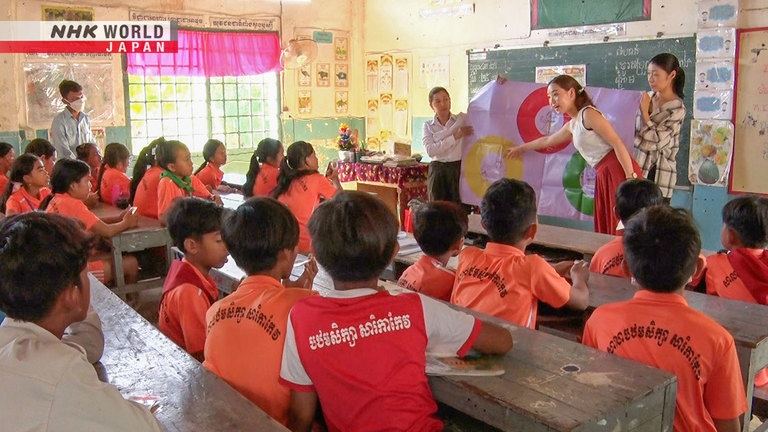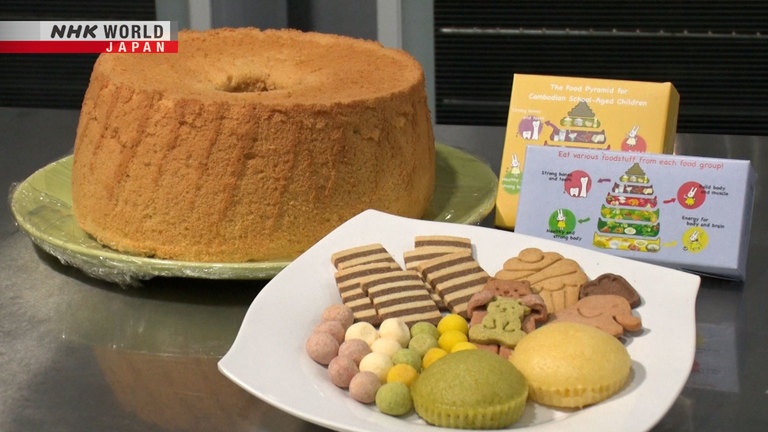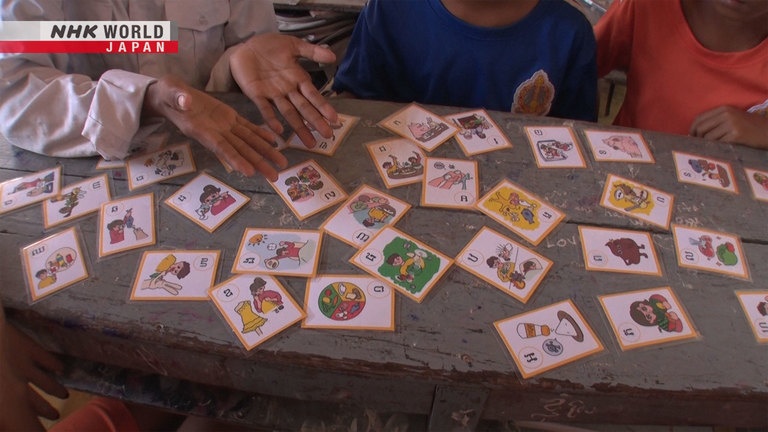Tackling Child Malnutrition via Healthy Snacks: Cambodia
In Cambodia, child malnutrition is a major issue, exacerbated by the ready availability of processed snacks and soft drinks at most school stores and canteens. To combat this, Japanese social entrepreneur Oji Hiroko worked with local colleagues to launch a new initiative providing schools with tasty, healthy snacks. She has also developed an educational card game that provides a chance to teach kids about diet and nutrition, both in school and with their families.



Transcript
An elementary school just outside Phnom Penh, capital of Cambodia.
For many children who arrive without having eaten breakfast,
a trip to the school store is an early high point of the day.
On sale are a vast array of cheap, processed snacks.
All packed full of flavor thanks to a surfeit of salt and fat.
Along with a selection of sugary soft drinks.
I drink one of these every day.
I have sweet tea and candy for breakfast.
And it's not just in the mornings - the stores are a popular hangout at breaktimes and after school, too.
We spoke to an expert on child nutrition.
When children are full of snacks,
they don't feel like eating at home.
But snacks don't have
the nutrition of home cooking.
So the result is child malnutrition.
But one social business is trying to counter such trends
through the provision of healthy, nutritious snacks.
Led by Japanese expat Oji Hiroko,
a former researcher into the dietary habits of Cambodian children.
The tasty, nutritionally balanced snacks are made with a focus on healthy, natural local ingredients.
And in schools, they provide a vital opportunity to teach children about the importance of good nutrition.
Children have so much potential.
And I think healthy children are key
to creating a healthy society.
This time on Sharing the Future, we follow a joint Japanese-Cambodian effort...
Tackling child malnutrition via healthy snacks.
Cambodia is a country in the midst of dramatic economic growth.
And with a median age of just 26.5, the population is dominated by younger generations.
We visit a suburb of the capital Phnom Penh.
Which is also the base of activities for Japanese expat Oji Hiroko.
In 2018, she launched a social business developing and selling healthy snacks aimed at local children.
Like these steamed cakes made using rice flour.
And this chiffon cake.
And all of these items are made with natural domestic ingredients.
These bite-sized cookies are crammed with local veggies.
Like much-hyped superfood moringa.
And fiber-rich root veg like sweet potatoes.
Some items even use more unexpected ingredients like protein-packed cricket meal,
and all provide a starting point for important conversations about diet and nutrition.
Spreadsheets help to ensure that every recipe is finely calibrated for key nutrients.
We want parents to understand
what goes into our products.
And choose them based on that.
Oji Hiroko first came to Cambodia in 2011, on a posting with a Japanese NGO.
Early on, she worked with the Ministry of Health to conduct a nutritional survey among school-age children.
We found chronic malnutrition was rife.
And I realized the importance
of doing something to help.
One point in particular stood out to Oji.
We found that 33.2% of children
had seen their growth stunted.
Due to long-term malnutrition.
These findings prompted a government resolution
to introduce nutritional classes to school curriculums by the year 2025.
But Oji realized that things couldn't wait that long.
I felt that a course in 10 years' time was
no good to kids in the here and now.
So I wanted to do something for them.
She left the NGO and in 2018 started her own business.
The concept of using snacks came from a teacher she met during the nutritional survey.
She said rules were all well and good,
but that practical change was vital.
That kids' lifestyles wouldn't improve
without better goods in school stores.
That's how I got the idea to use snacks.
Realizing an attitude shift to snacks was crucial to genuine progress,
Oji and her team began outreach activities to showcase the benefits of their wares.
We joined them at a special class for third graders.
The session begins with an introduction to the topic of nutrition.
With the school's cooperation these workshops take place in normal lesson time.
And this session is led by Oji team member Seng Sreyroth.
When you get one of these sheets,
please color what you ate this morning.
- What did you all have for breakfast?
- Rice.
OK then, color that in.
These coloring sheets are printed with a range of popular food and drinks.
Providing children with a starting point to think about their own nutritional intake.
After coloring in what they've eaten, they divide the items into three categories.
Green represents fruit and vegetables that help maintain health by keeping illness at bay.
While red represents growth-promoting protein-packed items like meat, fish, and eggs.
And yellow stands for energy-rich carbohydrates like rice, bread, and potatoes.
But some items are marked out for special caution.
Instant noodles, energy drinks,
and packaged snacks.
These aren't so good for you.
So let's fold over the page
to hide them.
At every meal, you need to have
something from each of these groups.
This boy hadn't colored any items in the green fruit and veg section.
Can you tell me a meal with
something from each group?
- Rice, fish, and vegetables.
- Each meal should have all three groups.
- Why's that important?
- For my health.
- And if you don't get all three?
- I could get sick.
We learned about food.
Foods that protect you, help you grow,
and foods that give you energy.
Next comes the part they've been looking forward to.
So for today, we've brought pumpkin toast.
It's good for your eyes. I hope you'll enjoy it.
The workshop and tasting session work in tandem to aid the children's learning.
Trying the snacks at the end of the session helps cement what they've been taught about nutrition.
They taste of pumpkin. They're yummy.
How does instructor Sreyroth see these classes?
I'm a mother too, so seeing these kids
reminds me of my own children.
I worry, because I have no idea
what they're eating at school.
So I try to get through to these kids
as if they were my own children.
An important ally on Oji's mission is school principal Heng Savath.
Their efforts have helped our children
to learn what foods are good for them.
Snacks were a big problem.
But I think since these activities started,
the health of our kids has improved.
We drop in on the school store...
And the shelves here are full of home made snacks.
The school placed a ban
on selling packaged snacks.
Traditional sweets are healthier for kids.
The cooperation of homeroom teachers like Heng Sopheak is also vital to shifting children's perception.
When we visited his class, it was as if
he was learning with the children.
I treated the sessions like I was a student.
At first, some kids felt like
the snacks weren't sweet enough.
But we explained that was because they
used the right amount of sugar for kids.
And that helped them understand.
It's thanks to the teachers' support
that the kids have made such progress.
At present, Oji and her team's activities are focused on a handful of public elementary schools around Phnom Penh.
Funded chiefly by supporters who make online purchases of snacks to be sent to schools.
The eventual aim is to achieve budget allocation from the schools themselves,
but the phase-one goal is simply to create touchpoints with as many schools as possible.
Yet the road to this point has been beset with various obstacles.
At first it was tough to gain acceptance among children used to the strong taste of processed snacks,
while some school vendors felt Oji's products were too expensive to sell.
But the breakthrough came when they were asked to provide desserts for the inpatient menu at a state-run pediatric hospital.
Winning praise for Oji's meticulous empirical approach to developing nutritious sweets.
The hospital has a strong reputation.
So the inclusion of our sweets on their
menu was a major turning point.
And to Oji, the challenge of developing recipes that are not only nutritious,
but also appeal to children's tastebuds remains a constant focus.
We joined her team as they discussed a new recipe idea.
Here's what I have in mind:
Coconut flavored, and white on top.
- Like a kind of jelly?
- Yes, that's it. Jelly.
- Do Cambodian kids like coconut?
- Yes, they love it.
- What do your nephews and nieces like?
- Coconut, and beans.
- What kind of beans?
- Any kind!
They have kids, or live with kids.
So they know what Cambodian kids like,
which is a massive help.
They head to the local market to buy ingredients for the new test recipe.
On their list are a coconut and some bean milk.
First they stop at a coconut stall.
One ripe coconut, please.
With the water, too.
But when they cut this coconut open...
This one looked nice and ripe,
but it's more water than flesh.
- This one is better.
- Oh, it's different?
So why don't we take this one and that one?
This one too, please.
They also buy some sweet bean milk.
Back at the kitchen, they quickly get down to experimenting.
The base is a coconut jelly with coconut chunks, topped with bean milk jelly shapes.
Onto this is poured another layer of coconut jelly.
And after setting in the fridge, here is the end result.
A colorful dessert with bean-based treats encased in coconut jelly.
But how does it taste?
It's a bit sour...
You're right. I think it's the coconut water.
The coconut wasn't ripe, so it's sour.
Next time, we need one that's just right.
Not too green and not too ripe.
The new recipe is going to take a little more refining.
Oji's educational workshops also incorporate a range of unique teaching aids.
Like these specially developed cards and picture books.
But the latest addition to the teaching toolkit has a distinctly Japanese twist.
Karuta is a traditional children's
card game from Japan.
I thought we needed a game
that could teach kids about nutrition.
Karuta is a traditional Japanese game thought to date back to the 16th century.
It uses two sets of cards, one with a poem or statement,
and the other with matching pictures marked with the initial sound of the text.
This set uses the 33 consonants found in the Khmer alphabet.
One player reads out a statement card.
While the others scramble to find the matching item from the scattered picture cards.
And in this set, all of the statements are informative nuggets about nutrition, diet, and health.
This card says, "Fruit and veggies keep you from getting sick."
While this one says, "You are what you eat."
The cards were designed on a volunteer basis by Japanese art school students,
with multiple edits to reflect differences between Japanese and Cambodian food culture.
Take this picture card for example,
"Chew your food well."
The initial design showed characters
eating rice from bowls, Japanese style.
But they don't eat like that in Cambodia,
so they couldn't tell this was rice.
They thought they were eating
ice cream from little bowls!
So we put the food on plates instead,
to show the characters chewing.
And after a year of development, Oji has high hopes for this novel take on karuta.
Chheth Yuswa, who worked here part time until he finished college last year,
also helped with the cards' development.
The karuta has been completeted, finally.
- So cute!
- Right?
I grew up in a children's home.
When we did nutrition workshops there,
the kids really took an interest.
And I think this game would
make things even more fun!
Oji recalls how important Yuswa's input was to the cards' creation.
He gave insights into local food culture,
and suggested framings that would work.
He provided all sorts of advice,
so it was very much a joint effort.
She gives him a set to take away with him.
I'll play with the kids at the orphanage!
I think they're going to love it!
- I will give you feedback.
- Oh, thank you so much. That's nice.
That would be very nice.
And that same afternoon, Oji heads out to see another key partner.
Nutritionist Matsunaga Mizuki arrived in Phnom Penh from Japan last night.
For the past two years she has provided expert input for Oji's activities.
- Has it been three years?
- About two.
She even provided nutritional advice
for the new card game.
But having collaborated remotely due to the pandemic,
today is actually the first time the pair have met in person.
Matsunaga also has first-hand insights into child malnutrition in Cambodia
from volunteering here during her college days.
The children seemed happy enough,
but many were small for their age.
I was in my second year studying
nutrition at university.
So I wondered if I could leverage that
specialty to help here somehow.
She took time off work especially to visit for the new card game's unveiling.
Today is also the first time she's met Sreyroth in person.
And she can't wait to check out the completed cards.
It's great to get my hands on them.
The yellow design feels cute and fun.
Matsunaga also lent her expertise to the development of workbooks designed to accompany the game.
Reading these will further deepen
the children's learning experience.
So it's great to have these, too.
The following day...
And the karuta sets are about to make their debut in one of Sreyroth's workshops.
Today's group is a class of fifth graders.
I'll read a card, and you find the picture.
- What do we do if we find the right card?
- Grab it.
- And if it's the wrong answer?
- Put it back.
That's right. Let's give it a try.
The kids are excited for their first karuta experience.
With the picture cards laid out, they're ready to start playing.
"Dark-colored fruit and veggies
are good for your eyes."
The first winner looks very pleased with himself.
OK, now here's the next one!
"We need food like a car needs gas."
The children take to the game almost instantly.
And the classroom is abuzz with enjoyment.
After finding each card, they read the explanation from the accompanying workbook.
"Your body is made up
of the things you eat."
Which helps to cement the learnings from playing the game.
And as always, the class is rounded off with some of Oji's healthy snacks.
As a final reminder to make dietary choices with health in mind.
The game and the lesson were fun.
I want to play it at home, too!
I'll avoid snacks and processed foods
to keep me healthy.
At the end of the game's classroom debut, Oji is more than satisfied.
It seems like a very useful teaching aid.
The kids were very engaged,
and they really absorbed the lessons.
We were able to combine the fun
with really effective learning.
Which was always our primary goal.
And as well as schools, Oji's nutritional karuta sets were also designed to be enjoyed at home.
As here on the outskirts of Phnom Penh.
Ten-year-old Edwin is small for his age,
so much so that he's receiving treatment at the national pediatric hospital.
And it was one of the doctors there that introduced his family to Oji's karuta set.
"Avoid soft drinks and energy drinks."
Got it?
It's a new kind of game for us.
I was amazed how the kids enjoy it.
And one card in particular has resonated with Edwin.
"Eat yummy, stay healthy!"
I want to eat well to be strong and healthy.
So the new game is also promoting dietary awareness in homes.
And to expand the fight against child malnutrition in Cambodia,
Oji is now taking her activities to other regions across the country.
There are lots more children out there
with limited awareness of nutrition.
I want to find those kids and give them
the opportunity to lead healthier lives.
That's my goal.
And Oji's core offering of healthy snacks is also evolving.
Today marks the debut of the coconut jelly they were working on,
available at this elementary school for the first time.
What's the verdict?
Yummy!
It's got pumpkin and coconut in it!
It's so pretty!
It's just the latest step in Oji's Hiroko's activities uniting Cambodia and Japan
in the fight against child malnutrition.
Because, as she and her team know,
healthier children are the foundation for a healthier society.